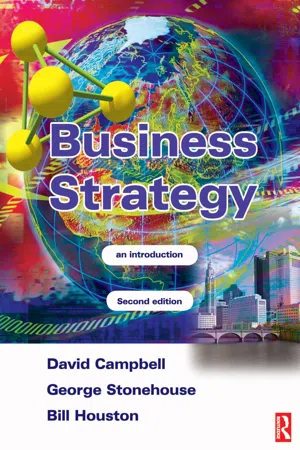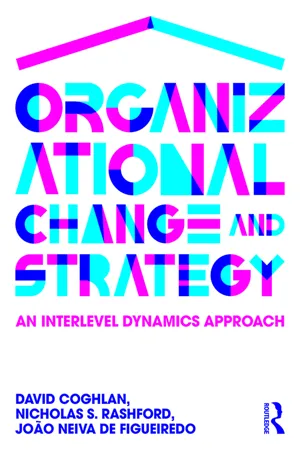Business
Identifying Options
Identifying options involves evaluating and selecting potential courses of action to address a business challenge or opportunity. This process typically involves brainstorming, research, and analysis to generate a range of possible solutions or strategies. By identifying and considering various options, businesses can make informed decisions and pursue the most promising paths forward.
Written by Perlego with AI-assistance
Related key terms
1 of 5
3 Key excerpts on "Identifying Options"
- eBook - ePub
- George Stonehouse, Bill Houston, David Campbell(Authors)
- 2003(Publication Date)
- Routledge(Publisher)
Chapter 9 Evaluation and selection of strategies
DOI: 10.4324/9780080476346-9Introduction and chapter overview
Important decisions are never easy. In order to ensure that we make the right choice in any given situation, we must first be in possession of all relevant information. This is the purpose of the strategic analysis stage – to ensure that the management of a business is fully aware of the internal strengths and weaknesses, and of the external opportunities and threats.The next stage in making an important decision is to be aware of all the options available. The most obvious choice is not necessarily the right one. Following the generation of options, the next stage is to evaluate each option using consistently applied criteria. The purpose of evaluation is to ensure that all options are assessed with equal thoroughness. Finally, strategic selection involves actually making a decision based upon the evaluation of the options.This chapter considers each of these stages in turn.Learning objectives
After studying this chapter, students should be able to:- describe the nature of strategic options;
- explain the key areas that strategic decisions concern;
- describe the four criteria that are applied to strategic options;
- understand the financial tools that can be used to evaluate strategic options;
- understand a number of other tools that can be used to evaluate strategic options;
- explain the limitations of an emergent approach to strategy when it comes to strategic evaluation and selection.
Identifying strategic options
The nature of strategic options
At the start of this chapter, we must remind ourselves of what makes a decision strategic in nature as opposed to one that is operational. We encountered these terms in Chapter 1 in the context of the nature of strategic objectives.Strategic decisions are taken at the highest level of an organization. They concern decisions on how the whole organization will be positioned with respect to its product and resource markets, its competitors and its macro influences. Accordingly, the options at the strategic level are those that offer solutions to the ‘big questions’ in this regard. - eBook - ePub
Market Analysis
Assessing Your Business Opportunities
- William Winston, Robert E Stevens, Philip K Sherwood, John Paul Dunn(Authors)
- 2013(Publication Date)
- Routledge(Publisher)
Exhibit 2-1 . Market opportunity analysis is the process which ties all these elements together to facilitate strategic choices which are consistent with all three areas.Exhibit 2-1 The strategic management process.A prerequisite to effective strategic planning is identifying the unit or level for which planning is to be done. Many companies have embraced a concept which is extremely useful in this strategic planning process—the strategic business unit.A strategic business unit (SBU) meets the following criteria:- It has a clearly defined market(s) which it serves,
- It is a full-fledged competitor in an external market as opposed to being an internal supplier. As such, it will have at least one identifiable competitor.
- It is a discrete unit-separate, distinct, and identifiable. It is possible to conduct integrated strategic planning related to markets, products, organizations, and facilities. Its assets do not depend on the existence of another SBU.
- Its manager has full control over critical decision areas related to success of the business.3
Once an organization’s SBUs are identified, the strategic planning can be carried out for each SBU. However, care must be exercised to ensure that the activities of each SBU are related to the corporate level objectives and purpose.Drucker has referred to an organization’s purpose as its mission or reason for being.4 To define a business’ purpose is to ask “What is our business and more importantly, what should it be?” Drucker further states,Only a clear definition of the mission and purpose of the business makes possible clear and realistic business objectives. It is the foundation for priorities, strategies, plans, and work assignments. It is the starting point for the design of managerial jobs and above all for the design of managerial structure.5One aspect of every firm’s purpose should be to meet a need in the marketplace. However, a statement of purpose needs to be a written statement which spells out in some detail the uniqueness that has led to the creation of the business enterprise. Such a statement becomes a reference point for subsequent managerial action. In effect, it becomes the reference point on which all operating areas in a firm must reflect as a part of their decision-making processes. A typical type of question faced by most firms is this: “Do we enter a particular market or introduce a particular product?” The starting point in answering should be how this decision relates to accomplishing the stated purpose of the organization. If it does not help the organization accomplish its stated purpose, it should not be undertaken, no matter how profitable or otherwise successful it appears to be; it is not aligned with the basic purpose of the enterprise. A firm’s purpose can be altered over time to reflect changing environmental conditions or changing managerial philosophies, but at any given point there must be a standard of relevance for managerial thought and action. - eBook - ePub
Organizational Change and Strategy
An Interlevel Dynamics Approach
- David Coghlan, Nicholas Rashford, João Neiva de Figueiredo(Authors)
- 2015(Publication Date)
- Routledge(Publisher)
This is a critical stage in strategy formulation. The methods chosen to do the analysis help determine the structure of the answers and therefore affect outcomes. In relational terms across the four levels, the task of doing analysis involves the complex involvement of senior management and organizational members in technical analytic activities that also may become highly political. In this chapter we first describe the technical content of analysing. We then explore the organizational processes through which analysis is conducted. Third, we examine roles in determining corporate alternatives by analysing and we conclude by discussing selected interlevel dynamics issues when conducting corporate analysis.The content of determining corporate alternatives by analysing
The analysis focus of the strategic management framework presented in this book is one that has received increased attention in recent decades. Indeed, over the past half-century the study of business strategy formulation and execution has increased in depth, breadth, sophistication, and number of tools. This significant deepening in the understanding and the implications of strategic management has sometimes led to the belief that this analysis phase is more important than others, a notion with which we strongly disagree: as described throughout Part III of this book, all five foci are fed by and in turn feed each one of the others and as such, they are all equally prominent and important. Because of the extensive literature on the content of business strategy analysis, with several streams of academic thought, including the resource-based view of the firm and the industry-based view of the firm, in this section we will succinctly describe the content framework of corporate analysis.Corporate strategic decisions usually are either related to strategy formulation or strategy execution. Strategy formulation involves the fine-tuning of goals and objectives and the establishment of a reliable roadmap to achieve them, which includes the translation from strategic goals to tactical objectives to operational tasks. Strategy execution involves the ongoing comparison between the formulated strategies and the emergent strategies, i.e. the constant examination of signals that are being received by the organization from various stakeholders, be they customers, employees, suppliers or the community, regarding unforeseen opportunities or threats. The organization needs to have a clear understanding of the top-down formulated strategy and also needs to be able to stimulate the emergence of alternative bottom-up strategies in order to incorporate on an incremental basis those that are promising and had not been considered beforehand. Most often these emergent strategies imply some degree of incremental change in the organization. In an unforgiving and unpredictable world, events often lead to a formulated strategy requiring radical change, and sometimes a first sign of possible need for more significant change can be difficulty in implementing incremental change, something which is often only recognized during the focus described in the next chapter covering choice and execution. This focus, determining corporate alternatives by analysing, is therefore an integral part of strategy formulation in addition to its role in examining emergent strategies on an ongoing basis. As a result, determining corporate alternatives should be a continuous effort throughout the corporation and the influences of this focus and effects on it from the other four foci should be attentively followed not only during times of strategy formulation, but also during the ongoing normal course of business.
Index pages curate the most relevant extracts from our library of academic textbooks. They’ve been created using an in-house natural language model (NLM), each adding context and meaning to key research topics.


